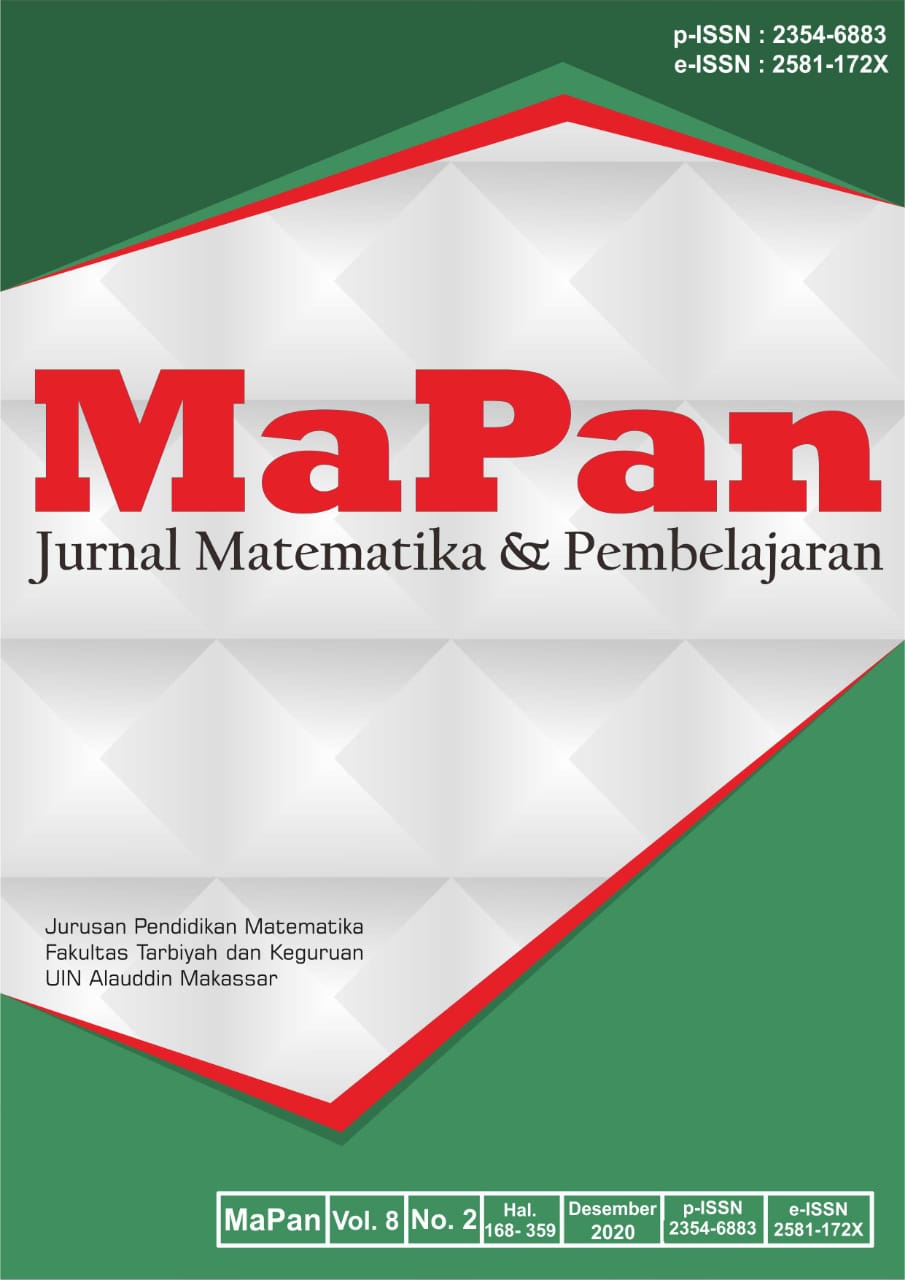IMPLEMENTATION OF SPACE GEOMETRY LEARNING USING GEOGEBRA TO IMPROVE PROBLEM SOLVING SKILLS
Abstract
Prospective mathematics teachers must be equipped with problem solving skills because it has a very important place in the mathematics curriculum. The purpose of this research is to get an overview of improving the problem solving skills of prospective mathematics teachers by implementing GeoGebra on space geometry learning. The research was conducted in Study Program of Mathematics Education, Tidar University in the second semester students. This research uses quasi-experimental method, with nonequivalent control group pretest-posttest design using two groups, namely experimental group consisting of 36 students got GeoGebra-based space geometry learning and control group consisting of 35 students got conventional space geometry learning. Research instruments in the form of observation sheets and test instruments in the form of pretest and posttest to measure achievements of problem solving skills improvement. The data obtained is then processed and analyzed by calculating the percentage of learning implementation and calculating the average normalized gain score (N-Gain). The results showed that GeoGebra-based Space Geometry learning can improve problem solving skills. In the experimental group, problem solving skills were improved in high category, while in the control group the improvement of problem solving skills in moderate category.Downloads
References
Abramovich, S. (2013). Computers in mathematics education: an introduction. Computers in the Schools, 30(1–2), 4–11. https://doi.org/10.1080/07380569.2013.765305.
Anderson, J. (2009). Mathematics curriculum development and the role of problem solving. ACSA Conference, 1–8. Sydney: The University of Sydney.
Bhagat, K. K., & Chang, C. Y. (2015). Incorporating GeoGebra into geometry learning-a lesson from India. Eurasia Journal of Mathematics, Science & Technology Education, 11(1), 77–86. https://doi.org/ 10.12973/eurasia.2015.1307a.
Carreira, S., Jones, K., Amado, N., Jacinto, H., & Nobre, S. (2016). Youngsters solving mathematical problems with technology. New York: Springer.
Cuban, L., Kirkpatrick, H., & Peck, C. (2001). High access and low use of technologies in high school classrooms: explaining an apparent paradox. American Educational Research Journal, 38(4), 813–834. Retrieved from http://www.jstor.org/stable/3202504.
Emaikwu, Oche, S., & Terseer, M. (2015). Effect of geogebra on senior secondary school students' interest and achievement in statistics in makurdi local government area of Benue State, Nigeria. Journal of Mathematics (IOSRJM), 14–21. Retrieved from http://www.iosrjournals. org/iosr-jm/papers/Vol11-issue3/Version-4/B011341421.pdf.
Hake, R. R. (1999). Interactive-engagement vs traditional methods: A six thousand student survey of mechanic test data for introductory physics courses. Journal of Physics, 66(1), 64–74. https://doi.org/10.1119/1.18809.
Hanafi, M. A. (2017). Deskripsi kesulitan belajar geometri mahasiswa program studi pendidikan matematika fakultas keguruan dan ilmu pendidikan Universitas Cokroaminoto Palopo. Seminar Nasional, 273–283. Retrieved from https://www.journal.uncp.ac.id/index.php/proceding/article/view/797.
Hohenwarter, M., Jarvis, D., & Lavicza, Z. (2009). Linking geometry, algebra, and mathematics teachers: geogebra software and the establishment of the international GeoGebra institute. International Journal for Technology in Mathematics Education, 16(2), 83–87. https://www.semanticscholar. org/paper/Linking-Geometry%2C-Algebra-and-Mathematics-Teachers %3A-Hohenwarter-Jarvis/f25381390d121df0cb6276af8820f218acc5354b.
Kurniasih, A. W., Wiyanti, D. T., & Zahid, M. Z. (2018). Visualisasi konsep matematika dalam pembelajaran menggunakan geogebra. PRISMA, Prosiding Seminar Nasional Matematika, 796–799. Retrieved from https://journal.unnes.ac.id/sju/index.php/prisma/article/view/2039.
Lestari, I. (2018). Pengembangan bahan ajar matematika dengan memanfaatkan geogebra untuk meningkatkan pemahaman konsep. GAUSS: Jurnal Pendidikan Matematika, 1(1), 26–36. https://doi.org/10.30656/gauss.v1i1.634.
Mahmudi, A. (2010). Membelajarkan geometri dengan program GeoGebra. Seminar Nasional Matematika dan Pendidikan Matematika, 469–477. Retrieved from https://eprints.uny.ac.id/10483.
Mudaly, V., & Fletcher, T. (2019). The effectiveness of geogebra when teaching linear functions using the IPad. Problems of Education in the 21st Century, 77(1), 55–81. https://doi.org/10.33225/pec/19.77.55.
NCTM. (2000). Six principles for school mathematics. Reston VA: The National Council of Teachers of Mathematics, Inc.
Ozturk, T., & Guven, B. (2016). Evaluating students’ beliefs in problem solving process: A case study. Eurasia Journal of Mathematics, Science and Technology Education, 12(3), 411–429. https://doi.org/10.12973/eurasia. 2016.1208a.
Pamungkas, M., Rahmawati, F., & Dinara, H. (2020). Integrating GeoGebra into space geometry in college. Journal of Physics and Conference Series, 1465. https://doi.org/10.2991/assehr.k.200129.123.
Polya, G. (2004). How to solve it. New Jersey: Princeton University Press.
Saha, R. A., Ayub, A. F. M., & Tarmizi, R. A. (2010). The Effects of geogebra on mathematics achievement: enlightening coordinate geometry learning. Procedia - Social and Behavioral Sciences, 8, 686–693. https://doi.org/ 10.1016/j.sbspro.2010.12.095.
Slameto. (2010). Belajar dan faktor-faktor yang mempengaruhinya. Jakarta: Rineka Cipta.
Stols, G., & Kriek, J. (2011). Why don’t all maths teachers use dynamic geometry software in their classrooms? Australasian Journal of Educational Technology, 27(1), 137–151. https://doi.org/10.14742/ajet. 988.
Susilo, B. E., Sutarto, H., & Mubarok, D. (2015). Pengembangan perangkat pembelajaran geometri ruang dengan model proving theorem. KREANO: Jurnal Matematika Kreatif-Inovatif, 6(2), 170–176. https://dx.doi.org/10.15294/kreano.v6i2.4979
Untarti, R., & Kusuma, A. B. (2018). Meningkatkan partisipasi aktif mahasiswa melalui lesson study pada mata kuliah geometri ruang. Jurnal Pendidikan Matematika dan IPA, 9(1), 15–30. https://dx.doi.org/10.26418/jpmipa.v9i1.23693.
Wahyuni, S., & Rahmadhani, E. (2019). Pelatihan penggunaan cabri 3D pada mata kuliah geometri. Jurnal Pengabdian Masyarakat MIPA dan Pendidikan MIPA, 3(1), 1–3. https://doi.org/10.21831/jpmmp.v3i1. 21958.
Copyright (c) 2020 Megita Dwi Pamungkas, Heny Nugroho

This work is licensed under a Creative Commons Attribution 4.0 International License.


